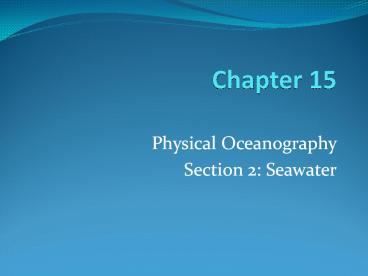Physical Oceanography PowerPoint PPT Presentation
1 / 17
Title: Physical Oceanography
1
Chapter 15
- Physical Oceanography
- Section 2 Seawater
2
Chapter 15.2 - Objectives
- I will
- Compare and contrast the physical and chemical
properties of seawater. - Explain ocean layering.
- Describe the formation of deep water masses.
3
Seawater is a solution
- Solution is a homogeneous mixture
- 96.5 water
- 3.5 dissolved salts.
- Most abundant salt is (NaCl)
- Other salts elements
- chlorides sulfates of magnesium
- Potassium
- Calcium
4
Salinity
- Measure of the amount of dissolved salts in
seawater. - Expressed in grams of salt per kilogram of water
or parts per thousand (ppt) - Total salt in seawater avg 35 ppt or 3.5
5
Seawater composition
- Salt Ions (ion is an atom that gains or loses an
electron) - Dissolved gases (oxygen, nitrogen, carbon dioxide
- Dissolved nutrients (nitrates, phosphates,
silicates) - These nutrients
- and gases greatly
- affect life in the
- oceans.
6
Major Ions in Seawater
7
Variations in Salinity
- High salinity- areas with high rates of
evaporation. - Low salinity areas where rivers empty into
oceans.
8
Sources of Sea Salt
- Salinity of ancient seas not much different than
today. - Magnesium in calcium-carbonate shells of marine
organisms. - Volcanoes- water vapor, gases (chlorine and
sulfur dioxide) - Weathering of Feldspar - Na, Ca, K
- Weathering of mineral and rocks - Fe, Mg
- These ions are flushed into rivers and
- transported in the oceans!
9
Removal of Sea Salts
- Salinity does not increase although salt ions
continuously are added to seawater. - WHY? Salts are removed at same rate as added
- Process to remove salts
- Precipitate forms deposits
- Marine Organisms- to
- build their shells, bones,
- teeth.
- Organism die solid parts
- drift to the ocean floor
10
Remember the water cycle?
11
Physical Properties of Seawater
- Density - Salt ions are heavier than water
molecules - Temperature
- Salinity
- Absorption of Light
12
Seawater vs. Freshwater
- SEAWATER
- More denser
- Density 1.02 g/cm3 to 1.03 g/cm3
- This density affects oceanic processes
- Freezing point -20C
- FRESHWATER
- Less denser
- Max density 1.oo g/cm3
- Freezing point 00C
Calculation d m/V
13
Absorption of Light
- Water absorbs light
- Light penetrates only upper 100m of seawater
- Below is darkness
- Photosynthesis exists top 100m
14
Ocean Layers caused by density differences
Warm, sunlit Rapid temp. decrease Cold, dark,
freezing temps.
15
Where does all the cold water come from?
- Polar seas
- Cold temp. causes seawater to become more dense
- Seawater freezes, sea ice forms
- Salt ions form beneath the ice
- Saltwater sinks, it migrates toward equator as
cold, deep water mass
16
Deep Water Masses
- Antarctic Bottom Water forms when sea freezes
below 00C - North Atlantic Deep Water forms off the shore of
Greenland - Antarctic Intermediate Water -least dense
17
End of Section 2

